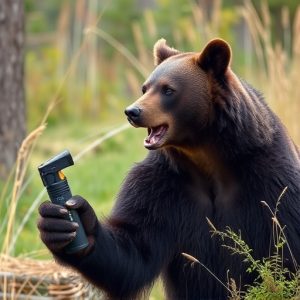Outdoor Safety: Understanding Bear Aggression & Effectiveness of Bear Spray
Understanding bear behavior is crucial for outdoor safety in areas with bear populations. While bear…….
Understanding bear behavior is crucial for outdoor safety in areas with bear populations. While bears usually avoid humans, they can become aggressive if threatened or surprised. Bear spray, with success rates from 70% to 95%, is an effective defense when combined with noise-making and other safety measures like proper food storage and garbage disposal. Familiarizing oneself with manufacturer instructions and practicing usage before entering bear country enhances the benefits of bear spray, ensuring a safer outdoor experience.
In many outdoor adventure hotspots, encountering aggressive bears is a real risk. Understanding bear behavior and equipping yourself with effective deterrents are crucial for safety. This article explores two key aspects: delving into the factors that make bears aggressive and dissecting the effectiveness of bear spray, supported by success rate statistics. We also provide additional outdoor safety measures to complement bear spray use, ensuring a more comprehensive approach to bear protection.
- Understanding Bear Behavior and Their Aggression
- Bear Spray: A Closer Look at Its Success Rate and Effective Use
- Additional Outdoor Safety Measures to Complement Bear Spray
Understanding Bear Behavior and Their Aggression
Understanding bear behavior is crucial when it comes to outdoor safety, especially in areas known for bear populations. Bears are typically solitary creatures and generally avoid humans, but they can become aggressive if they feel threatened or surprised. Aggression in bears can also be triggered by food sources, protecting their young, or territorial concerns. One of the most effective ways to minimize the risk of a bear attack is through proper preparation and knowledge.
Statistics show that bear spray has a high success rate in deterring aggressive bears. When used correctly, it can create a barrier between you and the bear, providing an escape route or time to retreat. However, it’s essential to remember that no single method guarantees 100% protection. Understanding bear behavior, staying alert, making noise while hiking, and carrying bear spray are all vital components of a comprehensive safety strategy in bear country.
Bear Spray: A Closer Look at Its Success Rate and Effective Use
Bear spray is a popular and widely used tool for outdoor enthusiasts and individuals living in bear country. When it comes to its success rate, various studies have been conducted to understand its effectiveness against aggressive bears. According to research, bear spray has shown promising results, with success rates ranging from 70% to 95% depending on the specific circumstances. These statistics highlight its potential as a valuable defense mechanism against bear attacks.
The effective use of bear spray involves several key factors. It is crucial to understand that bear spray is most successful when used in conjunction with other safety measures, such as making noise to deter bears and avoiding unexpected encounters. Users should follow the instructions provided by manufacturers and practice using the spray before venturing into potential bear country. By combining these precautions with the powerful deterrent effects of bear spray, individuals can significantly enhance their safety in areas where aggressive bears are present.
Additional Outdoor Safety Measures to Complement Bear Spray
In addition to bear spray, several other safety measures can significantly enhance your outdoor experience and reduce the risk of aggressive bear encounters. One effective strategy is to make noise while hiking or camping in bear country. Talking, singing, or playing music loudly can help deter bears from approaching, as they typically avoid human interaction. Carrying a whistle or using bells on your backpack is also beneficial, especially when navigating dense forests where conversations might not travel far.
Another crucial aspect is proper food storage and waste disposal. Bears are attracted to odours, so it’s essential to keep all food sealed tightly in bear-resistant containers or hang them high on trees. Never leave food unattended, and be cautious about cooking during your outdoor activities. Additionally, properly disposing of garbage and ensuring there’s no food residue left behind will minimize the chances of drawing bears to your camp. Remember that combining these measures with bear spray can significantly increase their success rate in deterring aggressive bears.
When it comes to outdoor safety, especially in bear country, understanding bear behavior and arming yourself with effective tools are key. Bear spray has proven to be a valuable asset, with success rate statistics showing significant deterrence against aggressive bears when used correctly. However, it should be complemented by additional safety measures like making noise while hiking and properly storing food to minimize potential encounters. By combining these strategies, outdoor enthusiasts can enhance their safety and enjoy the wilderness responsibly.


